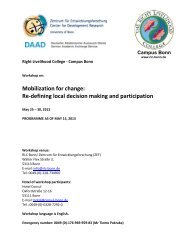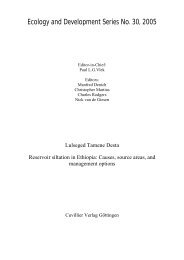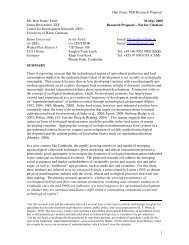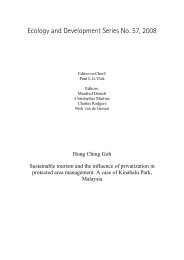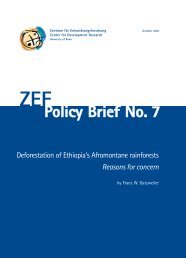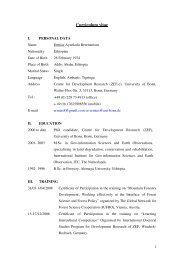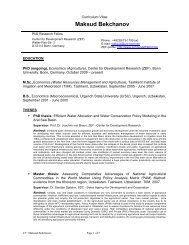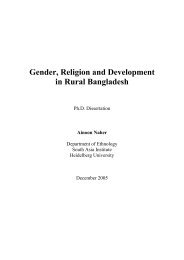Ecology and Development Series No. 10, 2003 - ZEF
Ecology and Development Series No. 10, 2003 - ZEF
Ecology and Development Series No. 10, 2003 - ZEF
- No tags were found...
Create successful ePaper yourself
Turn your PDF publications into a flip-book with our unique Google optimized e-Paper software.
Current state of knowledge2.2 Taxonomy, genetic diversity <strong>and</strong> reproductive biology of Coffea arabica2.2.1 TaxonomyThe genus Coffea belongs to the family Rubiaceae, which has around 500 genera <strong>and</strong> over6000 species. Rubiaceae is one of the largest families of flowering plants, mostly trees <strong>and</strong>shrubs, <strong>and</strong> more rarely herbs. Most species of the family occur in the tropics, particularlyin the lower story of tropical rain forests.New species of the genus Coffea are continually being discovered. Many newspecies have been discovered in recent years in the forests of Eastern Africa (Bridson 1982)<strong>and</strong> Madagascar (Davis 2001; Davis <strong>and</strong> Rakotonasolo 2000, 2001a, 2001b). In total,around 92 species of Coffea are currently recognized, of which 45 species occur inMadagascar, 44 in Africa, <strong>and</strong> three in the Mascarenes (Dulloo 1998; Davis <strong>and</strong>Rakotonasolo 2001a).Leroy (1980) recognized three subgenera of Coffea. These are: subgen. Coffea(ca. 90 spp.), subgen. Baracoffea (Leroy) Leroy (ca. 4 spp.), <strong>and</strong> a monotypic subgen.Psilanthopsis (A. Chev.) Leroy. According to Bridson (1994), however, it is not worthy toconsider Psilanthopsis as a subgenus, <strong>and</strong> recommended it to be placed in subgen. Coffea.C. arabica is the type species for the genus <strong>and</strong> belongs to the subgen. Coffea.Several phenotypically deviating populations <strong>and</strong> lines of cultivars have beenformally recognized as varieties of C. arabica (var. bourbon Choussy, var. typica Cramer,)but there has been no clear distinction between cultivars (including l<strong>and</strong> races) <strong>and</strong> the wildpopulations (Bridson <strong>and</strong> Verdcourt 1988). The naming of botanical varieties of C. arabicain literature is confounded due to mix up with cultivars. Cultivars are actually to be namedunder a different system, the code for cultivated plants (Trehane et al. 1995) <strong>and</strong> are to betreated separate from naturally occurring infraspecific variation. Hence, further research isnecessary to clarify these issues.Sylvain (1955, 1958) attempted to systematically classify the coffee cultivarsgrowing in Ethiopia. In his classification, he recognized 12 major types based on tree habit,leaf color <strong>and</strong> size, calyx characteristics, size <strong>and</strong> shape of fruits <strong>and</strong> seeds, <strong>and</strong> the yieldingability. For naming, he used the names of the locality where the coffee types were found.The 12 Ethiopian coffee types of Sylvain (1955, 1958) are the Enarea, Jimma or Kaffa,15



